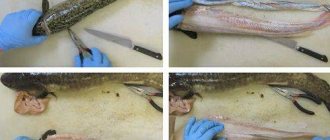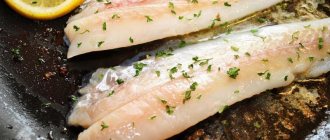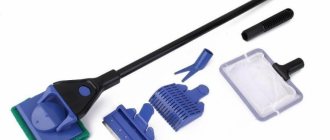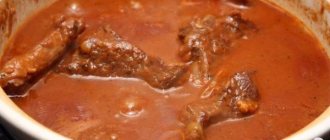The main condition for preparing fish dishes is the correct cutting of the main ingredient. Today we’ll tell you how to clean and properly cut fish from the burbot family so that dishes from it turn out delicious.
What do you prefer?
- Red fish 47%, 225 votes
225 votes 47%225 votes - 47% of all votes
- Crustaceans/molluscs 40%, 192 votes
192 votes 40%
192 votes - 40% of all votes
- White fish 13%, 64 votes
64 votes 13%
64 votes - 13% of all votes
Total votes: 481
18.04.2020
- Red fish 47%, 225 votes
225 votes 47%225 votes - 47% of all votes
- Crustaceans/molluscs 40%, 192 votes
192 votes 40%
192 votes - 40% of all votes
- White fish 13%, 64 votes
64 votes 13%
64 votes - 13% of all votes
Total votes: 481
18.04.2020
×
You or from your IP have already voted.
Burbot: features of the species
Burbot is a freshwater fish of the burbot family, order of codfish. Adults of the species can grow up to 120 cm in length.
Representatives of burbot are characterized by the presence of a long, elongated body and a serpentine head, equipped with three mustaches (two on the upper jaw and one on the chin), as well as a large number of small bristle-like teeth.
The abdomen is white with a yellow tint. The body, depending on the age and habitat of the individual, can have a dark or light gray-green color. A characteristic feature of the species is the presence of brown stripes and spots on the back. The body of the burbot is covered with small, almost invisible scales. Long, low fins are located on the back, near the throat and in the tail area.
The meat is white, similar to cod, the structure is dense. The content of proteins, polyunsaturated fatty acids and minerals in meat makes burbot a product beneficial for human health.
Features and value of burbot fish
Burbot is a tasty and healthy fish, most valuable fresh
Burbot is the only freshwater representative of the Cod order, predominantly marine fish. It prefers cool waters, so it is often found in Russian rivers and lakes. Burbot has an unusual appearance: the peculiarity of cod fish is the presence of a small antennae on the chin. The fish is covered with a very small scaly covering that fits tightly to the skin; the fins are soft, without spiny rays.
Burbot meat is tasty and nutritious, and its liver is a real delicacy valued by gourmets and doctors. Burbot is not caught in industrial quantities, since it is not found anywhere in large quantities and has the greatest culinary value, like sterlet, only live or fresh. Note that frozen burbot meat quickly loses its internal juices, becomes fibrous, limp and tasteless.
Burbot meat is a valuable dietary food product, the regular consumption of which has a beneficial effect on the general condition of a person. It is enough to eat burbot meat once a week to strengthen the heart muscle and prevent the risk of heart attack and stroke.
How to clean it properly?
Cutting burbot for frying is not a difficult task. This can be done in two ways, differing from each other in that in the first case the skin is removed before cutting, and in the other (alternative) - after.
In a professional kitchen, special devices are used to cut burbot. At home you can make do with familiar items.
You can prepare burbot by having on hand:
- a special board that is used exclusively for fish. If there is none, you can replace it with a sheet of thick paper;
- scissors and a sharp knife (ideally use a special fish knife);
- pliers for gripping slippery skin;
- tweezers for removing bones;
- coarse salt to cleanse the mucous coating.
Skin removal
The first thing to do before frying is to remove the skin.
To remove it:
- rub the burbot with coarse salt, then rinse it off with water at room temperature. This helps cleanse the skin of surface mucus and scales;
- cut off the fins using scissors or pull them out with pliers, making cuts along each;
- make an incision in the skin around the head in the area where it joins the body;
- grab the burbot skin with your fingers or pliers and carefully remove it (you should get a stocking);
- carefully examine the subcutaneous layer for the presence of parasites. If the latter are present, problem areas are cut out.
Advice! If the skin of the burbot comes off with difficulty, it is recommended to carefully trim it with a knife during the pulling process.
Video of the process sequence:
Removing the entrails
The entrails should be removed carefully so as not to damage the integrity of the internal organs and to prevent their contents from entering the cavity of the fish.
For this purpose:
- make a neat incision from the anal fin to the base of the head;
- take out the insides. It is better to do this with your hands, because a knife can pierce the gallbladder and hopelessly ruin the product;
- remove the inner film by prying it off with the end of a sharp knife;
- washed with water at room temperature.
Fish cutting
How to cut burbot for frying?
During the cutting process:
- cut off the edge of the abdomen (tesha);
- carefully remove the liver and remove the head;
- cut the carcass into pieces of the required size;
- if it is necessary to obtain a fillet, make a cut along the spine and divide the carcass into two parts;
- remove the bones using tweezers.
Watching the video will help you properly cut fish for frying:
How to properly clean burbot
Burbot is suitable for preparing almost any fish dish, but people are reluctant to use this fish because they believe that it is very difficult to clean. Although this is not particularly difficult. You just need to remove the skin along with the scales. This is done in the following sequence:
- To make cutting burbot pleasant, it is better to immediately wash off the mucus from it. To do this, rub the fish with coarse salt and rinse with warm water.
- Having placed the fish on a prepared surface (cutting board or spread paper), use the end of a knife to make a shallow incision in the abdomen from the head to the anus.
- Carefully remove the insides so as not to crush the gallbladder.
- Separate the liver (set aside for cooking). If you have milk or caviar, you can leave them too. Discard the remaining innards.
- Remove the gills and cut off the fins - they are not needed. There is no need to cut off the tail, as it, along with the spinal bones and head, is useful for making broth or fish soup.
- Make a shallow circular cut behind the gill slits.
- Holding the strip of skin near the cut with pliers, carefully tighten the skin with a “stocking”.
Further actions depend on what dish you are going to cook. You can separate the head and tail, bake the rest of the carcass whole or fry in portions. Or you can separate the fillet and prepare dishes from the pulp (minced meat or batter), and use the bones to make broth.
In order to remove the fillet from the carcass, you need to lay it on its side, then use the tip of a knife to make an incision along the spine just above the spinal bones from head to tail. The incision must be gradually deepened until the blade rests on the rib bones. You should work carefully so as not to cut them. Turning the blade parallel to the ribs, remove the pulp from them. Then, lifting the flesh removed from the front of the carcass, cut the fillet from the tail, cutting it with a knife along the spine and spinal bones.
Turn the fish over and remove the fillet from the other side in the same way.
You can first remove the skin from the burbot, and then gut and separate the fillet, but in this case it is easy to damage the peritoneum and it will be much more difficult to further process the fish.
It is easy to remove the skin from fairly large fish. It is difficult to clean small burbot in this way. Therefore, it is better to salt it and then dry it. But small burbot, hot or cold smoked, turns out much tastier.
Burbot dishes are often served in expensive restaurants. The predatory representative of the cod family has tender and tasty meat and almost no bones. However, housewives rarely use this fish in home cooking: the taste is unpleasant. This is because few people know the rules for cleaning and gutting a carcass. But if you want, you can clean it at home. To do this, it is important to know some of the nuances of the procedure.
Alternative method of cleaning and cutting
An alternative method of preparing fish for frying involves removing the skin at the end of the cutting process.
For this:
- clean the skin of mucus and small scales, then rinse well. You can clean burbot using coarse salt or a knife;
- Without removing the skin, an incision is made from the anal fin to the base of the head, after which the entrails are removed;
- Cut the fish along the line connecting the head with the body on both sides in the direction from the abdomen to the ridge. The head is not removed.
- an incision is made from top to bottom along the ridge line and the spine and head are carefully removed;
- Using tweezers, remove the remaining bones;
- remove the skin. You need to remove it by grabbing the edge of the burbot's head with pliers or special tongs.
Advice! It is possible to remove the skin without problems only from large fish. It is better to salt or smoke small ones.
How to properly separate fillets?
The fillet is not separated from the bones in isolated cases, for example, when you plan to bake the carcass. Here it will be enough to separate the head and tail. In any case, these components dry out and are not used for food; it is better to put them in broth. The process of separating the fillet is very simple and requires only a certain skill.
- We lay the carcass on its side, using the sharp part of the knife to mark the place of the cut from head to tail, along the line of the spine.
- We draw the blade again, deepening the cut. We move forward until we hit the place where the ribs are attached to the ridge. We work carefully, do not cut off the bones, otherwise they will then have to be removed from the fillet manually.
- Now we move the blade parallel to the ribs, removing the pulp from them. As soon as the opportunity arises, we lift the fillet, hold it with our fingers and now we are no longer working blindly, but clearly maintaining the boundaries and capturing the meat to the maximum.
- Work begins from the head part, gradually moving to the tail. After you manage to remove the meat from one half, turn the workpiece over and proceed in the same way with the second part. True, this time it will not be so convenient, so you need to be extra careful.
- Some cooks first remove the skin from the burbot, then gut it and separate the fillet. But this option is more troublesome and less accurate.
This manipulation will not cause any difficulties only if you have to process a large burbot. With this approach, you will have to cut off too much meat from small burbot, so it is better to deal with it differently. We clean the carcasses, salt them, and then prepare dried fish from them. And the blanks can be smoked hot or cold, if they are not very small.
How to prepare frozen burbot?
Ideally, use fresh or chilled burbot for frying. If this is not possible, you can cook frozen fish.
How to clean burbot? Need to:
- defrost the fish and wash it with warm water;
- clean off mucus and scales and rinse again;
- cut the abdomen in the direction from the anal fin to the neck and remove the insides, trying to prevent damage to the gallbladder;
- remove the film inside the cavity;
- cut off the tail and head, and cut the remaining carcass into pieces optimal for frying.
Advice! The skin of frozen fish can be removed after cutting into portions.
Cutting
- Cut off the head. If it will be used for further cooking, first remove the gills.
- Cut off the tail and cut off the fins using a knife or culinary scissors.
- If necessary, cut the carcass into portions.
Fileting
Some dishes require the use of fish fillets.
To get it:
- Place the cleaned fish sideways on the cutting surface and, using a sharp knife, make a longitudinal cut along the spine slightly above the spinal bones from head to tail.
We make a cut along the ridge and deepen it until we hit the ribs - Using a knife blade, we go deeper into the incision until it touches the rib bones.
- Using short movements, moving parallel to the ribs, separate the pulp.
Burbot does not have small bones. Therefore, the meat is easily separated from the backbone and ribs.
- We cut off the resulting fillet at the tail, trimming it near the spine and spinal bones.
- Place the fish on the other side and repeat the filleting process.
Burbot meat has an exquisite taste and delicate texture, which is not even affected by the type of processing. Unfortunately, few people know how to clean burbot, so this product is not included in the diet of many families. In fact, everything is quite simple, because the fins of the individual are not equipped with sharp spines, and its fillet does not contain small bones. It only takes a few minutes to thoroughly clean the carcass. Moreover, some of the insides do not have to be thrown away; they can also be used to prepare gourmet dishes.











